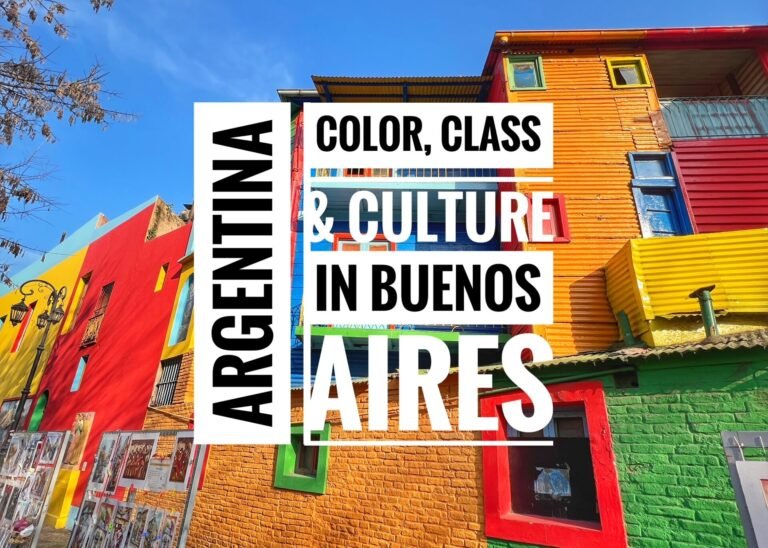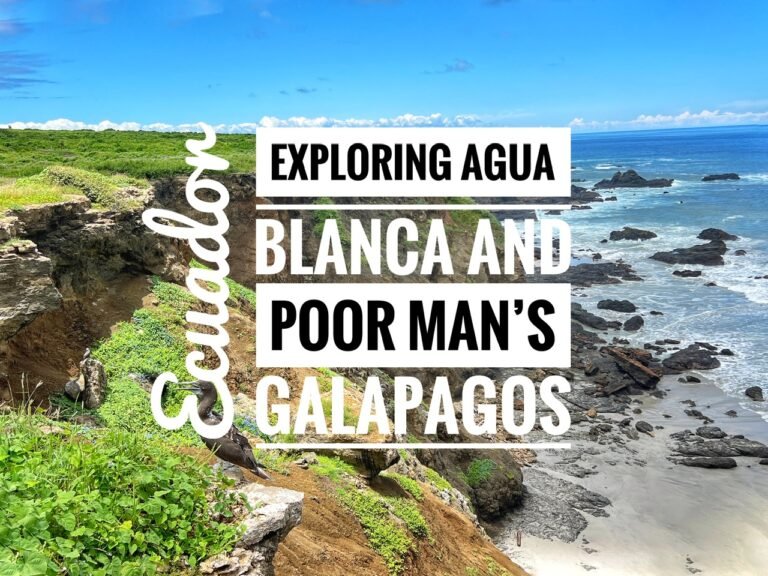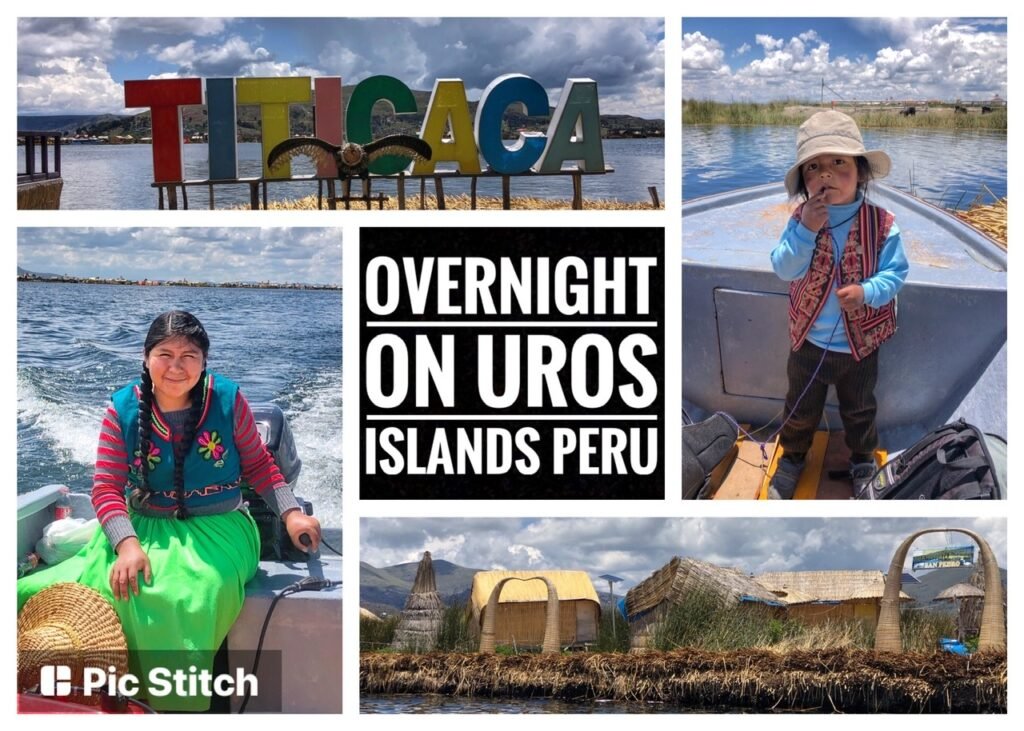
The shimmering sheet of cobalt water of Lake Titicaca (3830 meters/12,565 feet) is the world’s highest navigable lake and the islands upon it are renowned for their tranquility, beauty and indigenous communities. Thus, we knew doing a simple day trip or overnight, as most tourists do, was not an option for us. We wanted to witness the living tradition of their agrarian cultures as much as possible, and, we discovered it’s absolutely feasible to experience it independently, for an extended period, and on a budget. We chose to spend one night on Uros, and extended to four on Taquile. We also wanted to stay on Amantani. However, the only way to get there from Taquile was by incredibly expensive private boat.
Our first stop was the floating human-made Uros Islands community of 2000 people which are the most visited for their peculiarity and uniqueness. They are only seven km from the shore. In Uros, you don’t buy land…you create it. These islands include meters deep layers upon layers of tortora reeds which make them feel a bit springy and squishy to the step. Kinda like walking on straw blanketed waterbed.

Our host, Henry picked us up from a dock north of Puno (see below for details), the main Peruvian transport hub of the lake. The dock was called Puerto Palapaja and was virtually in the middle of nowhere. When we arrived, we were greeted by a lady with long braids and multicolored pom poms in her hair. Everyone wanted to know…A. do you want to buy a sombrero? (because we weren’t wearing one, which seems to be a criminal offense in Peru…And B. Where are you going? Everyone seemed satisfied with “La casa de Henry” as the answer.



Henry, who we crazily found on Airbnb, arrived in a fishing boat about 15 minutes later with a little mini Henry called Gaul, or something like this. We immediately glided our way into the reed canals, which are the extraordinary life force used to make EVERYTHING in Uros. It was easy to let out a sigh as the luscious blue sky sun dripped onto our pasty gringo skin. The highs on Titicaca are typically around the mid-60’s (19 Celsius). In short, very pleasant….until night time.


About 20 minutes later, we floated up to the official Uros welcome island where we stepped on the unorthodox landing pad for the first time. It was here we paid the entrance fee to the islands which was 8 sols or $2/each. It was also here we could begin seeing how the islands are fabricated with the buoyant totora reeds that grow copiously in the shallow areas of the lake.

Mini Henry…age 3. Mischievous as it gets and already learning the art of being a Uroeno from his papa.

What Henry called “the Mercedes Benz” of the boats in the islands. They are typically used for tourist outings and are made with a shell of plastic water bottles (Wow! Way to repurpose!), wrapped in a tarp and then packaged neatly by tortora reeds.

Arriving to Henry’s family island, Tata Willka, and our home for the night. He lives there with his wife, son, and his wife’s siblings and their families. The cost of one night was $26 and we found it on AirBnb.

As mentioned, everything on this island…and all 140 islands…is predominantly made of tortora reeds. Including our little hut. It reminded us of one of the first unfortunate houses in the Three Little Pigs story. Fortunately, their were no wolves around (or even dogs!) and also, it was a bit sturdier than it looked.


In fact, it was downright cozy, including about four insanely heavy blankets that made you feel like you’re sleeping under a lead blanket at the dentist’s office. And the view from the window? Couldn’t be better. Literally on top of the lake.

And the real surprise? Our room even had a bathroom. Granted, it reminded Mandy of the piece meal bathroom she made in her “hideout” as a kid, but still perfectly functional including a bucket sink, urinal and compostable potty complete with what seemed to be upscale plastic tablecloths on the walls. Perfect for this glamping experience on an island made of straw!

In addition to the foundations of the islands themselves and big tourist boasts, the reeds are used for making canoes, or “romantic rides” as Henry called them. Since there are no discotecas or bars in Uros, this is how you woo your mate.


After we settled into our room, which took three minutes, Henry settled us in these chairs under…what else? An umbrella made of straw. And, as usual, bouncing across the reeds to get there was so much fun! Greg felt grateful.

Especially as we observed the men of the little island slog around cutting down reeds. The top layers of reeds is about 3-4 meters (9-13 feet) deep and has to be replenished every 10-15 days because it compresses and rots over time. There is also a base “root” foundation which is a meter deep. Thus, it’s a continuous work in progress that has been going on for more than 200 years. And the best part? They seem happy. Really happy.
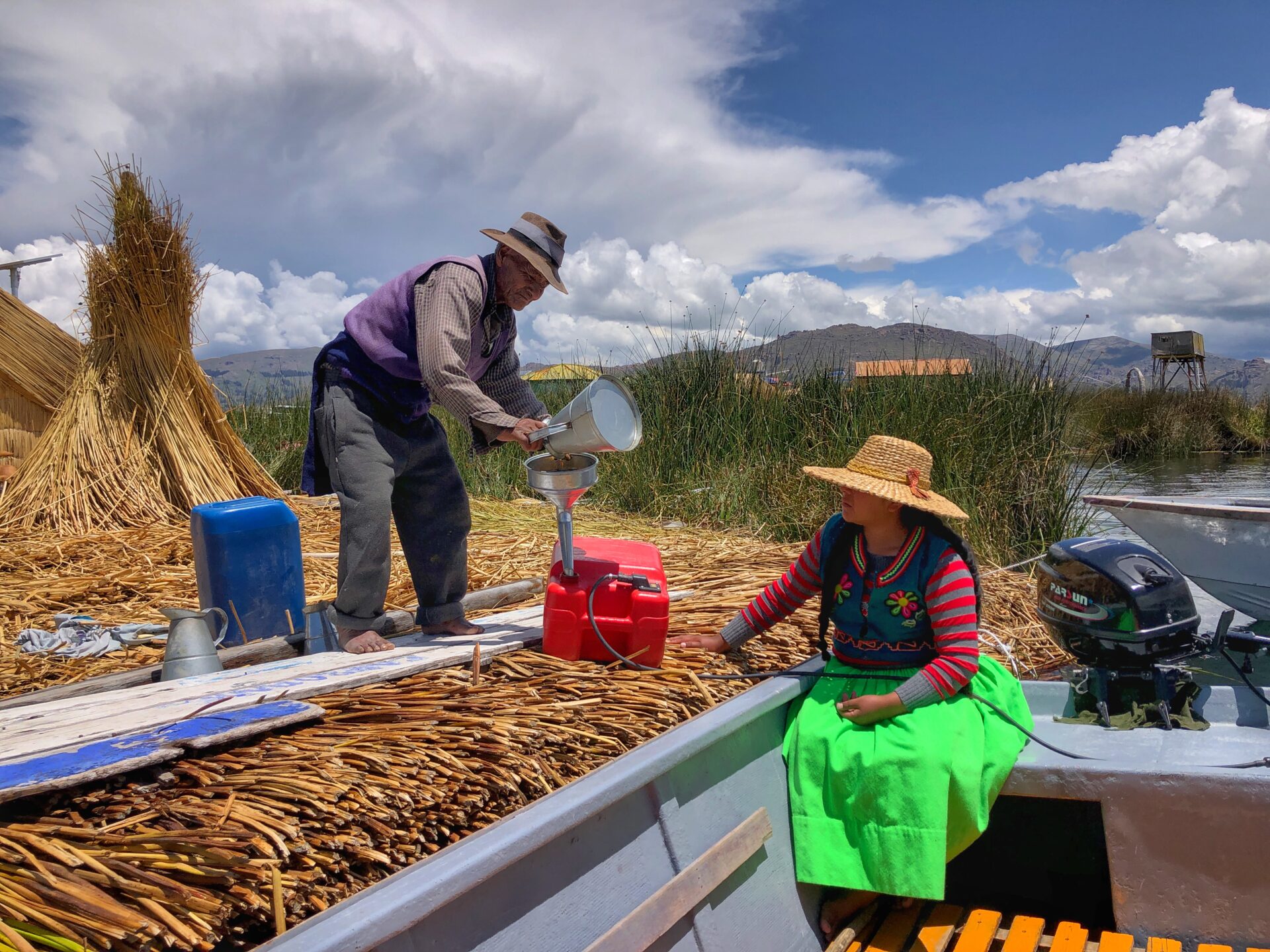
Henry’s wife then took us to a lunch at one of the few locals restaurants in the community, but first we had to get petrol on “the gas island.” This involved pulling over to an island where a sturdy little old man, who looked nearly 80, hauled a giant gas canister across the slippery bounce house surface and filled our boat’s tank. Fascinating.

A close up of the island’s foundation. It continues far below the surface of the water.

A token welcome sign on “the restaurant island” so you don’t forget where you are.

And since the airport official never stamped our passport in Peru, this was also where we grabbed our first unofficial passport stamp. Mandy was against this because she didn’t want to take up valuable space in our passports, but Greg twisted her arm. This happened to be way prettier than the official ones, anyhow. However, it did cost a sol ($.25).


The restaurant where we ate.

And our first, of the delicious Omega-3 packed daily trout lunches we would have over the upcoming six (!) days. (25 sols or ~$6.) Trout was introduced to Lake Titicaca by the Bolivians, on the other side of the lake around 1975. The supply surprisingly came from Canada. Now, it’s a regular staple for the inhabitants.

It was quite fascinating to see their systems on the island. Water is collected and heated by the sun for hot water, all electricity is solar-powered, waste is picked up by a boat twice a week and sewage is removed outside of the community. (More on this shortly.) The people of Uros really seem to recognize the finite value of their precious resource.

And…some people even have satellite TV. But where to place the dish?!

The “restaurant island”, complete with a reed-manufactured ostrich. Why not?

Henry’s wife drove us to and from the restaurant and was incredibly sweet. Like the rest of the family, she spoke Spanish and her native tongue which is called Aymara. Aymara is spoken commonly on Titicaca’s islands and Quechua, the same native language spoken in Cusco, is spoken north of Titicaca. It’s not uncommon for people to be trilingual in this area.

After lunch, the weather turned and we became quarantined to our little hut. It was interesting and cozy to experience the rain pounding on the tin roof and the very subtle sway of the ground beneath us. Nothing like being on a boat, but still faintly detectable.

This is a map of the Uros islands. As mentioned there are 140 of them and you can see the sheer number of homestay options, although some appear to be floating on the lake. You can also see where ours was located by the blue dot.

Eating at our homestay was in a separate hut and was surprisingly well-rounded healthy meals. The breakfast was included and the dinner cost 30 sols each ($7.50).

And for the night, Henry sent us to bed with hot water bottles wrapped in flannel to sandwich into our blankets. This was very thoughtful considering the wind was whipping all night and temperatures were hovering in the mid-30’s Fahrenheit (2 Celsius). How ingenious. We were toasty snug.

The next morning we woke to beautiful blue skies and calm water on the lake. This picture is truly representative of the contrast of life on Lake Titicaca. In the foreground, you can see an island of Uros. In the background, the city of Puno. Although COVID hit the community hard from a tourism perspective, they were able to continue living sustainably with no major issues, while Puno struggled more. It’s truly a testament to an authentic lifestyle in these rural communities.


After breakfast, Henry plopped us down in the reeds for “school” where he taught us more about the lake and islands. It was here he broke out the fact he could speak English too. ? This was 30 sols/$7.50 each and well worth it.
Some facts he shared:
- Despite what our English and Spanish language systems want us to think, the meaning of Titicaca is quite different. Titi means “puma” in the local language and “Caca” means grey.
- This is due to the shape of the lake. This seems completely ludicrous until the map is rotated 90 degrees and using your indigenous cloud-gazing or I-had-too-many-coca-leaves imagination, you can see a puma, next to a rabbit.
- 60% of the lake is in Peru and 40% in Bolivia. Lamentably, the land border is still closed or we’d be wandering into the next country.
- The lake is 165 kilometers wide (103 miles).
- There are four rivers that flow into the lake, and one that flows out.

This is a representation of how the islands are made…the one meter root foundation, 3-4 meters of reeds, and houses and boats on top. The house on the left is a traditional house, and the one on the right is modern day. In the past, the “Mercedes Benz” boats were used as temporary housing while families built their homes on the islands. Remarkably the islands are anchored by about 12 points. Not straight down, but straight out like a star.
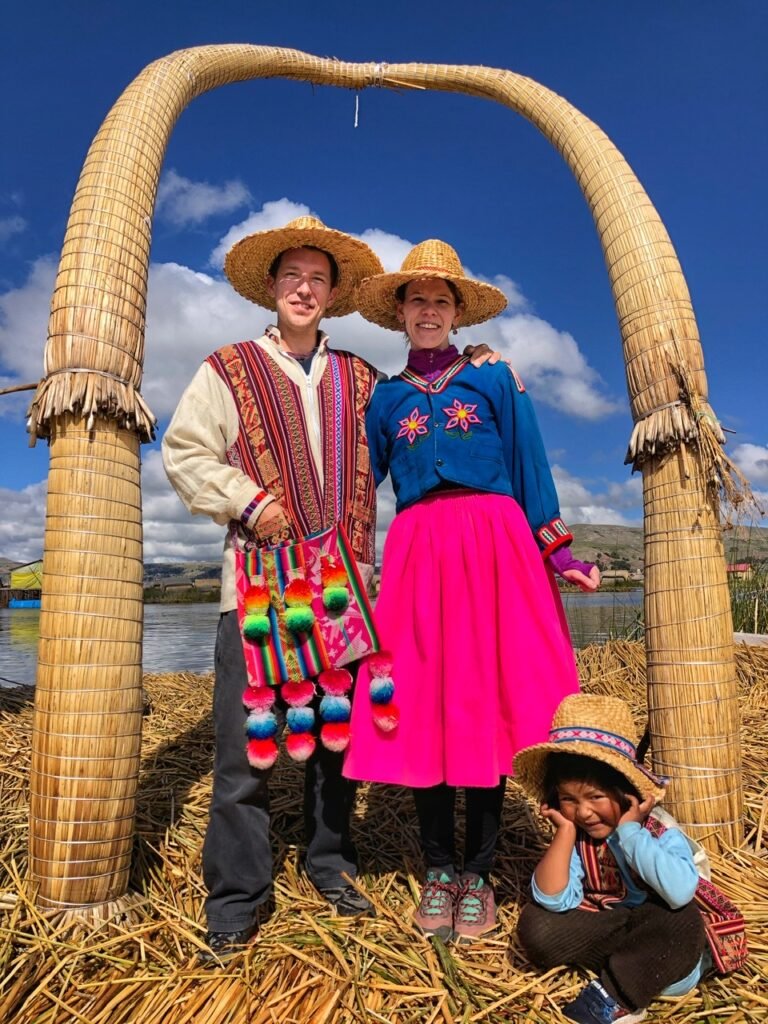
Henry then gave us an opportunity that Mandy jumped at…dressing up in traditional clothing, which they still wear regularly. We even acquired a little kid for our family photo in the process!

Henry also took us out in the boat to explain how he fishes. In the afternoons, he ties a fishing net to a select reed (who knows how he finds it?), and then drops several dozen meters of fishing line in the water. The next day, we all went to collect the net. In it, Henry extracted at least 20 palm-sized fish that resembled sardines. These fish will provide protein to their family for several days and are typically used in soups. Fortunately, there is no commercial fishing allowed on Lake Titicaca, which is probably how these communities have continued to survive.

Henry was happy because that was a good catch. This is one of five predominant jobs he does for his family, which also includes working with the reeds, hunting for birds, collecting duck eggs, and of course, tourism. Women are responsible for cooking, making tapestries and crafts for tourism, and the bulk of child rising.

After we collected the fish, Henry gave us a brief tour of the community. We learned Uros is run by a local president, who is elected and volunteer-based every two years. The current president is even a woman.
This is the Adventist Church. Although 90% of the population is Catholic, the Adventists have managed to capture the attention of a few more.
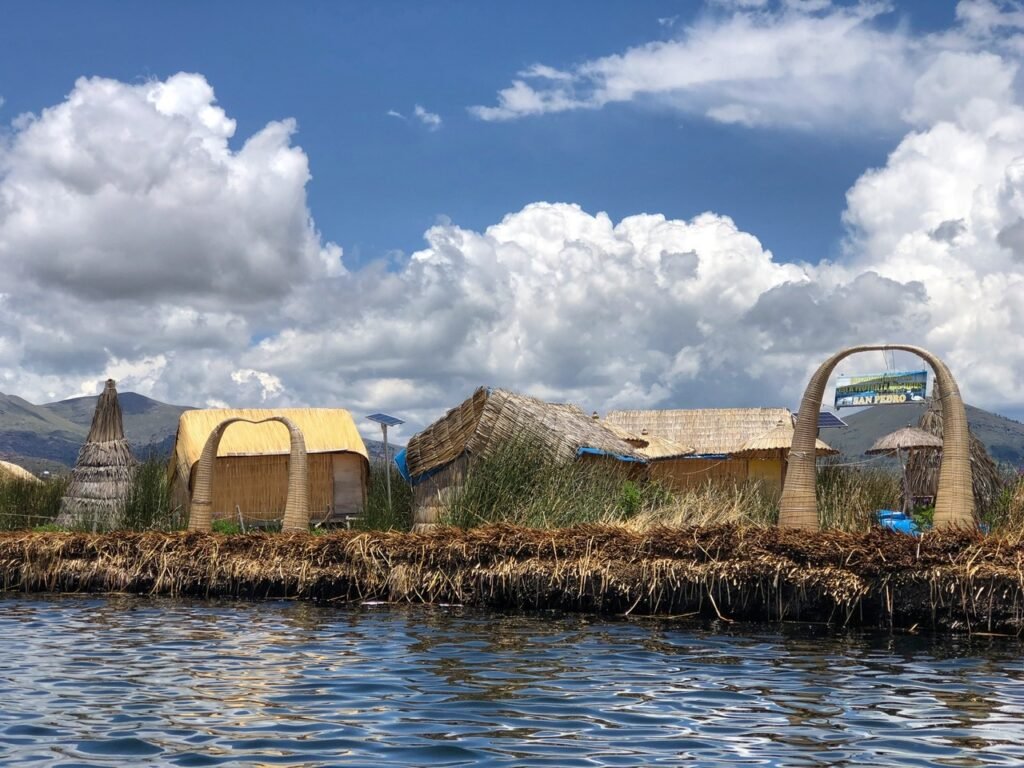
Another island with many types of structures.

This is the elementary school. Formal elementary education goes from kindergarten to age 12. After that, the children must go to the city (Puno) for secondary education, including trade schools and English, which is much needed for tourism. Of course, this additional education costs money, which not all families are fortunate enough to have. Most children surprisingly return to the community after they’ve finished secondary education.

Quite a contrast.

Sewage. We were amazed to learn that every island residents sewage is collected in tanks, and thankfully not all pipes drain into Lake Titicaca. Incredibly, the Uros Islands residents seem very well aware that they need to take good care of their aquatic home and not pollute it with, umm… caca. This means hauling out each and every households sewage tanks’ contents, once they are full, to a proper disposal facility back on land. This effort for environmental stewardship also translates to rubbish, where a rubbish collection boat circles around to each island collecting the days trash for disposal on land. We’re impressed.

The football pitch. It can’t be easy to deal with foul balls in this environment.

The community even has a small hospital.
Overall, we were pleased to see that a community like this exists. It seems highly functioning, sustainable and like a happy place to be and we were grateful for the short experience to live and contibute to life here.
Where to Start Your Journey to the Titicaca Islands: Puno
To get to Puno on Lake Titicaca we took a seven-hour tourist bus from the Colca transport hub of Chivay, which was a whopping 125 sols/each or $33. Unfortunately, this is the only way to do it, unless you re-route four hours back through Arequipa which didn’t make a lot of sense. However, because we were on the tourist bus, we got to travel during sane (daytime) hours), we stopped at some interesting sites we wouldn’t have seen otherwise, received blankets and climate control, and got blasted with opportunities to buy Peruvian handicrafts.



Our first stop was at a mirador overlooking Volcan Hualaca Hualaca at 6025 meters or 19,767 feet (basically Denali). Fortunately, we saw this on the way to Colca Canyon because we weren’t seeing nothin’ on this particular day. Same with this other mirador. But FFS, was it cold.
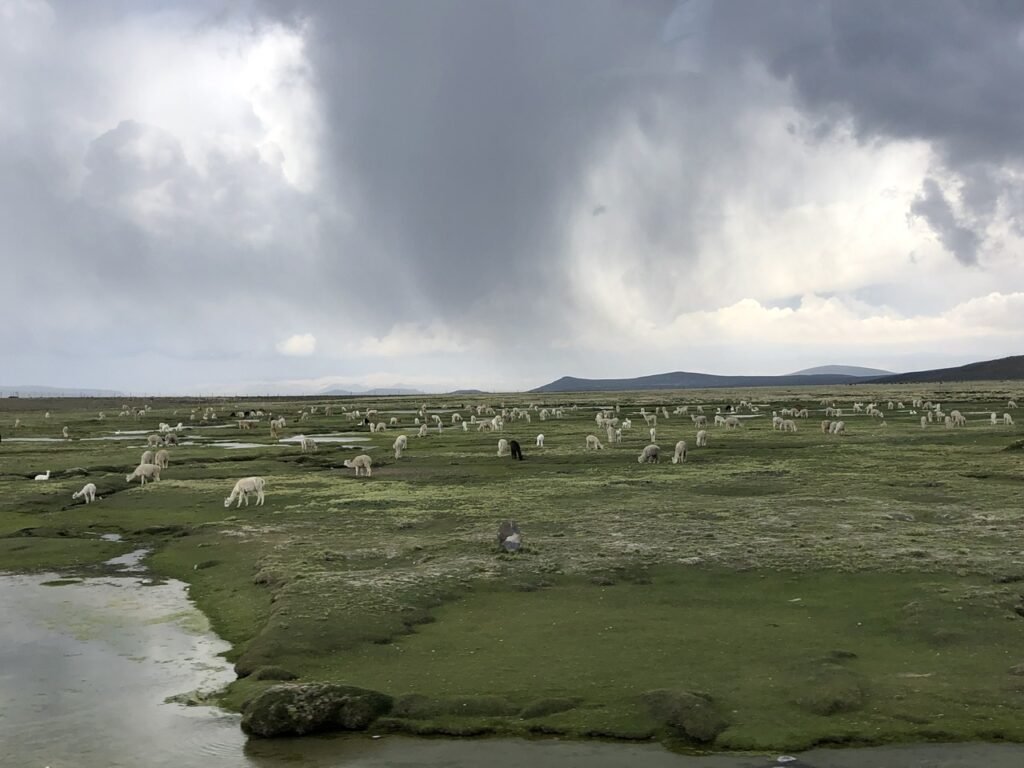
Llamas and alpaca as far as the eye could see.

Greg standing with the Peruvian national flag, and the Peruvian national animal.

We arrived to Puno at 7:30 in the evening and were greeted with a gust of substantially colder temperatures than Colca. We checked into a rare treat…a three-star hotel called Casona Plaza Hotel which we scored on Booking.com for $16 (normally $65), thanks to our “Genius Level 3” status. We’re preferring Booking more and more to the fee-hungry Airbnb these days and trying not to support them as much.


Our room. We spent three nights here. One on the way to the islands and two on the return. It included a large hot buffet breakfast, which was also a rare treat for us. Side note…drinking the water in Puno was no bueno, even with the use of our Steripen, although we found it tasted fine to drink on the islands.

The city of Puno (population 149,000) is a bit gritty and bit charming, depending on where you go.

The Plaza de Armas. Apparently ever main square in Peru has this name.

One of the charming bits.

We went to the main Puno dock beforehand to purchase our island to island tickets, which saved us 60 sols each ($16) from buying a tour.

Stocking up on nuts and dried fruits before we headed to the islands.

Greg tried the traditional Peruvian dish, Aji de Gallina, or Garlic Chicken as one of his Menu de Turístico options (15 sols or $3.75) It’s a chicken stew in a “spicy,” nutty, cheese sauce at least according the internets. His didn’t have a hint of spice or nuts and was a bit bland.

On February 27, all the vendors were out getting ready for Carnaval celebrations. They start this week and festivities include throwing flowers in the air like confetti and sprinkling the around their homes and businesses.

Inside a regular supermarket. In order to get into the supermarket you must be double masked, or have on an N95 and show your vaccine card.



Along the malecon in Puno was very pleasant and artsy. They even had a mural on the walkway that was dedicated to the people who lost their lives during COVID, which was the first we had seen of its kind. Peru was tragically the country with the largest number of people lost per capita thanks to the pandemic.

